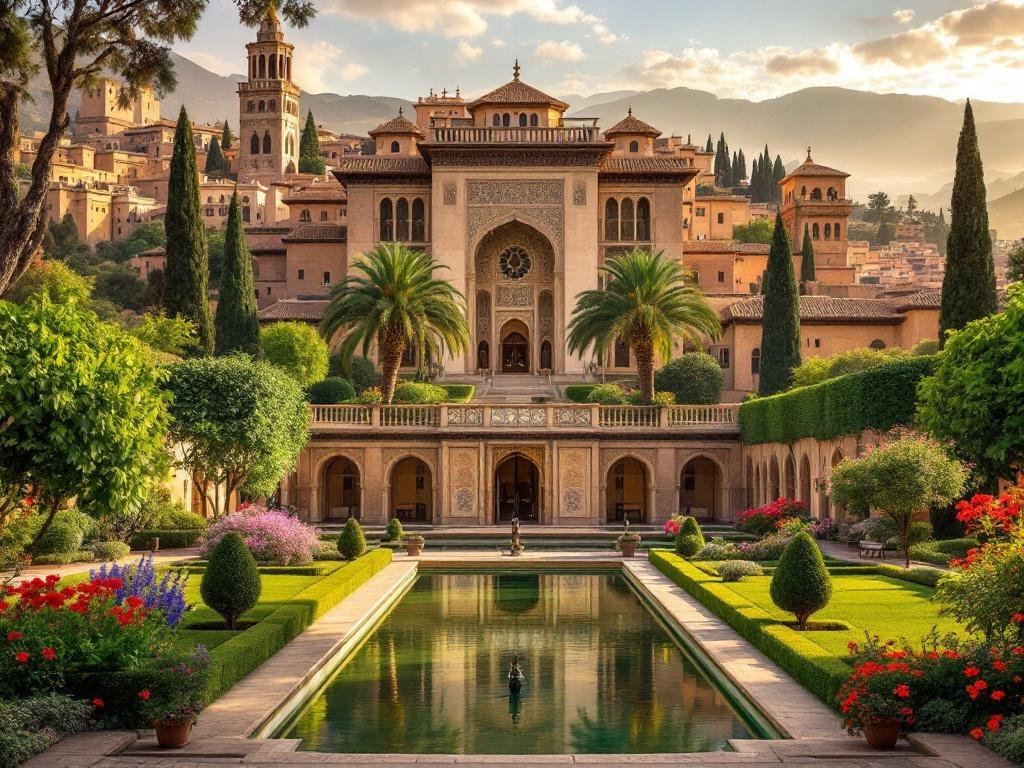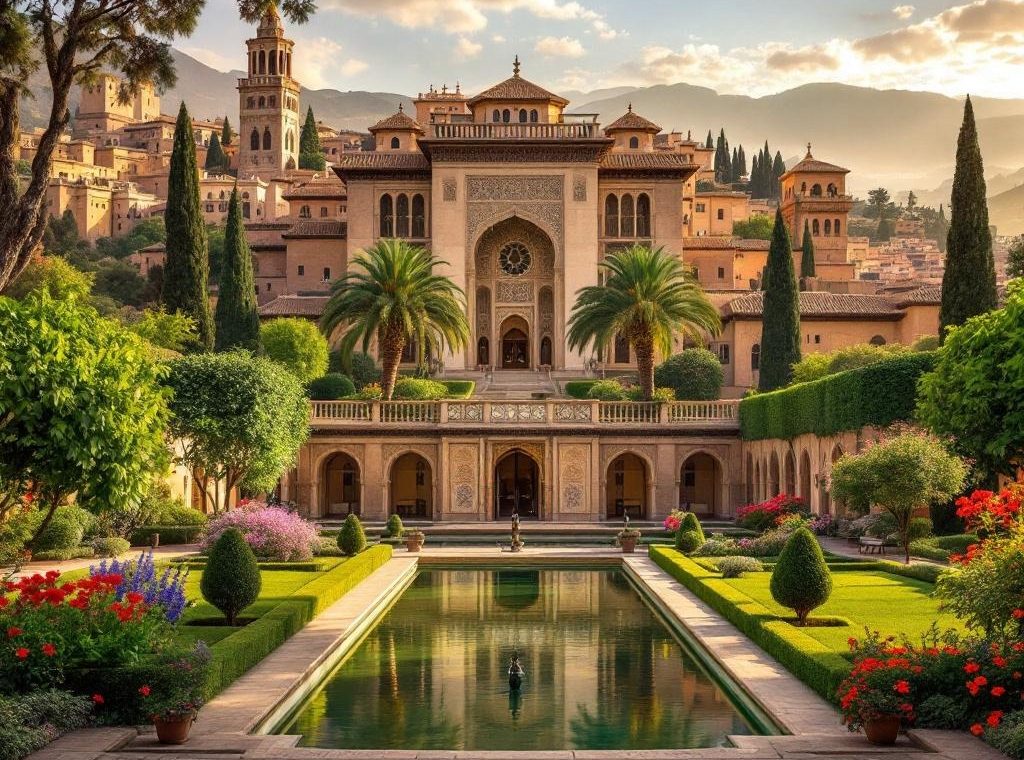Discovering the Alhambra Palace in Granada
Journey back to the pinnacle of Moorish art and architecture at the Alhambra, a breathtaking palace and UNESCO World Heritage site in Granada, Spain. Discover the legacy of the Nasrid dynasty, whose reign (1230-1492) shaped this architectural marvel, blending Islamic and Christian influences. Explore stunning towers, tranquil gardens, and ingenious aqueducts, all while uncovering the intricate artistry within the Nasrid Palaces, Alcazaba fortress, and Generalife gardens. Unravel the stories behind the exquisite tilework, calligraphy, and geometric patterns, and capture breathtaking panoramic views of Granada. Plan your visit today and experience the magic of the Alhambra.
Important information

- The Alhambra, a UNESCO World Heritage site, is a pinnacle of Moorish art and architecture in Europe, showcasing a blend of Islamic and Christian influences.
- Built by the Nasrid dynasty (1230-1492), it features key areas like the Nasrid Palaces (including the Court of the Lions), the Alcazaba fortress, and the Generalife gardens.
- Visitors can enjoy stunning panoramic views of Granada and the Sierra Nevada mountains from the Torre de la Vela and the Generalife.
- Pre-booking tickets online is essential due to limited daily capacity. Skip-the-line options and audio guides are available to enhance your visit.
- Spring and fall offer the best time to visit for pleasant weather and fewer crowds.
Historical Significance and Cultural Heritage
The Alhambra, a magnificent palace in Granada, Spain, is a UNESCO World Heritage site representing the pinnacle of Moorish art and architecture in Europe. Showcasing the powerful reign of the Nasrid dynasty, its intricate design blends Islamic and Christian influences to remarkable effect. Designated a World Heritage site in 1984, the Alhambra solidified its global importance as a crucial cultural and historical landmark. Before you travel, make sure you have the necessary visa or permits. Check the latest entry requirements here: Check if you need a visa or other travel documents
Role of the Nasrid Dynasty in Alhambra’s History
From 1230 to 1492, the Nasrid dynasty ruled Granada, transforming the Alhambra into a magnificent royal palace. They expanded the complex and added iconic structures like the Palace of the Lions and the Court of the Myrtles. The Alhambra’s beauty reflects the dynasty’s dedication to arts and sciences, showcased through intricate architecture, calligraphy, and gardens. Ironically, this era represented the final stage of Muslim rule in Spain before the Reconquista.
Moorish and Christian Architectural Influence
The Alhambra’s beauty stems from its unique blend of Moorish and Christian architecture. Intricate Moorish artistry is evident in the stucco, calligraphy, and geometric patterns. Following the Reconquista, Renaissance elements emerged, showcased in structures like the Palace of Charles V. This fusion results in a stunning and singular aesthetic.
UNESCO World Heritage Site Status
Recognized as a UNESCO World Heritage Site in 1984, the Alhambra’s stunning architecture and cultural significance draw millions of visitors annually, solidifying its status as a global treasure.
Architectural Marvel of the Alhambra
The Alhambra is renowned for its exquisite architecture, boasting stunning towers, tranquil gardens, and ingenious aqueducts. These elements create a place of both beauty and historical significance. Key examples within the complex include the Nasrid Palaces, Generalife, and Alcazaba, showcasing Moorish and Islamic architectural styles. Intricate tile work, stucco decoration, and calligraphy adorn the walls, further enhancing the artistry of this true masterpiece.
Prominent Features: Towers, Gardens, and Aqueducts
The Alhambra boasts magnificent towers, such as the Torre de la Vela and Torre del Homenaje, which offer stunning panoramic views. Equally impressive are the Generalife gardens, with their diverse flora and ingenious water features. These intricate systems rely on historic aqueducts that once supplied water to both the Alhambra and the city of Granada.
Geometrical Shapes and Qur’anic Calligraphy
Islamic art often showcases geometric patterns, such as stars and polygons. These intricate designs appear in various media, including mosaics, stucco, and carved wood, with the Alhambra in Spain serving as a prime example. Stylized Qur’anic verses in Kufic and other scripts also adorn the walls, typically praising God or describing the palace and its function. This harmonious blend of geometric designs and calligraphy creates a powerful visual statement, reflecting the importance of beauty and faith within Islamic culture.
Exquisite Artwork and Craftsmanship
The Alhambra’s artistry is breathtaking. From its elaborate stucco and vibrant zellige tile mosaics to the ornately carved artesonado wood ceilings, every surface bursts with intricate detail. Geometric patterns, flowing arabesques, and calligraphic inscriptions from the Quran combine artistry and symbolism, reflecting the rich cultural and religious heritage of the Nasrid dynasty.
Main Areas of the Alhambra Complex
The Nasrid Palaces are breathtaking examples of Moorish architecture, featuring stunning details like the renowned Court of the Lions.
The Alcazaba, the oldest part of the complex, originally served as a military fortress.
The Generalife, the sultan’s summer retreat, showcases exquisite gardens, orchards, and refreshing water features.
Nasrid Palaces: Court of the Lions and More
The Alhambra’s core, the Nasrid Palaces, comprises three distinct areas:
Mexuar
The oldest area, once a meeting place for ministers.
Comares Palace
Houses the magnificent Throne Room.
Palace of the Lions
Known for its breathtaking central courtyard and intricate stucco work, featuring the iconic Court of the Lions with twelve marble lions encircling a central fountain.
Throughout these palaces, the beauty of Islamic art shines through calligraphy, geometric patterns, and ornate tilework. Tranquil water features, like fountains and pools, enhance the overall design and atmosphere.
Alcazaba Fortress: Historical Military Stronghold
The Alcazaba, the Alhambra’s oldest section, served as a crucial military fortress, strategically positioned to defend the entire complex. This must-see is a prime example of Moorish military architecture.
Generalife Gardens: Sultan’s Summer Retreat
The Generalife served as a tranquil summer escape for the Nasrid sultans, offering respite from the Alhambra’s formal atmosphere. Its stunning gardens, filled with lush vegetation, sparkling fountains, and peaceful courtyards, exemplify Moorish design while providing breathtaking views of Granada.
Stunning Panoramic Views and Photography Tips
The Alcazaba fortress provides spectacular panoramic views of Granada. Its highest point, the Torre de la Vela, offers truly exceptional vistas. From here, you can admire the city sprawling below, the surrounding plains, and the distant peaks of the Sierra Nevada.
The breathtaking Generalife gardens offer another perspective, overlooking the Alhambra with the Sierra Nevada mountains as a dramatic backdrop. These meticulously manicured gardens, with their fountains, pools, and lush vegetation, provide a tranquil escape and stunning photo opportunities.
To fully appreciate the Alhambra’s grandeur, explore various vantage points throughout the city. The Mirador de San Nicolás is renowned for its iconic sunset views, casting a warm glow over the palace. The Albaicín neighborhood, with its narrow winding streets and traditional houses, presents unique and intimate perspectives of the Alhambra. A wide-angle lens is highly recommended to capture the Alhambra’s scale and its majestic integration with the cityscape.
Best Spots for Breathtaking Views
The Alcazaba fortress offers breathtaking views of Granada stretching below.
Even more impressive panoramas await from the Torre de la Vela, the Alhambra’s highest point.
But for a truly unique perspective, explore the Generalife gardens, where you can admire both the Alhambra’s palaces and the city beyond.
From these vantage points, the Alhambra’s remarkable integration with its surroundings becomes strikingly clear.
Capturing the Alhambra’s Dominance Over Granada
The Alhambra’s grandeur is immediately apparent, perched high above Granada. Its towers, walls, and gardens create a striking contrast against the cityscape below, a testament to its historical significance. From this vantage point, photographers capture stunning panoramas of the Alhambra’s imposing architecture against the backdrop of Granada, showcasing a captivating interplay of history and landscape.
Visitor Experience and Practical Tips
Plan your Alhambra visit for spring (April-May) or fall (September-October) to enjoy pleasant weather and fewer crowds. Summer (June-August) can be extremely hot, while winter (November-March) is less crowded but can be chilly.Book your tickets online in advance through the official website or authorized vendors to secure your entry due to limited daily availability. Consider purchasing skip-the-line tickets to save valuable time.The Alhambra offers good accessibility, with wheelchair access in many areas. Enhance your visit with an audio guide, available for rent upon arrival, providing insights into the palace’s history, architecture, and gardens in multiple languages.
Best Time and Season to Visit
Spring (April-June) offers delightful weather and colorful gardens.
Autumn (September-November) shares this charm, providing a respite from the summer crowds.
For a truly serene experience, arrive early in the morning or in the late afternoon.
Ticket Availability and Skip-the-Line Options
Secure your entry by booking in advance. Daily capacity is limited, so pre-booking guarantees your spot and minimizes waiting time. Plus, enjoy expedited entry with pre-booked tickets, allowing you to skip the line entirely.
Accessibility and Audioguides
The Alhambra welcomes visitors with disabilities, providing accessible routes and facilities for effortless exploration. Enhance your visit with audio guides available in multiple languages, detailing the palace’s rich history, intricate architecture, and captivating artistry.
Insider Tips for a Memorable Alhambra Visit
Plan your visit to [Attraction Name] by choosing a self-guided tour for independent exploration or a guided tour for historical context. Select the option that best suits your learning style and interests. Reserve your tickets online in advance due to high demand. Enhance your visit with audio guides and maps, available upon arrival. While we strive for smooth visitor flow, expect crowds during peak season.
Self-Guided Visits Versus Guided Tours
Chart your own course with a self-guided tour and relish the freedom.
A guided tour offers enriching historical and architectural insights from expert guides.
Select the experience that best fits your preferences.
Crowd Management and Visitor Services
The Alhambra Palace limits daily visitors to manage crowds, enhancing the visitor experience and making your visit more enjoyable.
Enhancing Your Visit with Cultural Activities
The Alhambra and Generalife Patronato offers unique cultural events providing amazing experiences connected to these historic sites. These activities give visitors a deeper understanding and appreciation of the Alhambra and Generalife. Special tours, for instance, explore hidden details, while concerts fill the palace with vibrant music. Beyond entertainment, the Patronato also preserves this important heritage, ensuring future generations can experience its wonder.
Events
- special tours exploring hidden details,
- concerts filling the palace with vibrant music.
Patronato’s role
- provides amazing experiences connected to the historic sites,
- gives visitors a deeper understanding and appreciation of the Alhambra and Generalife,
- preserves this important heritage for future generations.
Patronato de la Alhambra y Generalife: Events and Experiences
The Alhambra and Generalife Foundation enhances the visitor experience with a variety of cultural events. These include concerts, exhibitions, and educational opportunities that illuminate the site’s heritage. They offer a unique way to connect with the Alhambra, fostering a deeper appreciation of its history and cultural significance.















